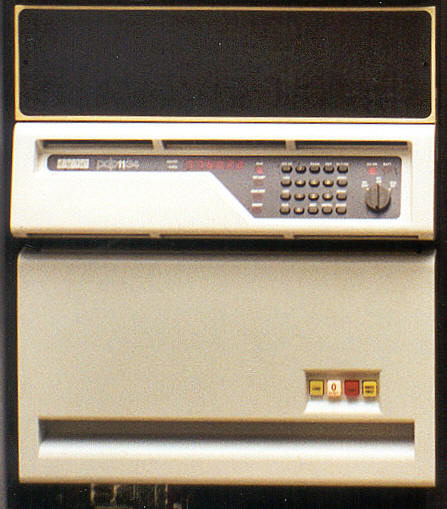PDP11/34

<<< *** >>> ^^^
| Manufacturer: | Digital Equipment Corporation |
| Type: | PDP11/34 |
| Year: | 1976 |
| Technology: | TTL (ALU with four SN74S181) big parts of the logic realized with bipolar ROMs 128 kwords with 16 bit MOS memory |
| Price: | (We sold our grandma's little house...) |
In 1970, Digital Equipment launched a new computer series on the market: The PDP11. Unlike all other machines from DEC, this series has a word length of 16 bits. Although, for the sake of consistency, the octal numbering system is still deployed.
The first model was the PDP11/20. It had 4 kwords of core memory and a frontpanel similar to the panel of the PDP8. Later on more models were introduced, for example the PDP11/45 in 1972, PDP11/70 and so on. Due to the big success of this family, by the end of the 70s the VAX11/750 respectively 11/780 were introduced as a kind of an improved PDP11 with 32 bits.
Also other manufactures had been inspired by the PDP11: the microprocessor M68000 from Motorola, for example, can be seen as a PDP11-GTI. It has twice as many registers (16 vs. 8) that are twice as large (32 vs. 16 bits). The instruction set and syntax of the assembly language are quite similar. It is, in contrary to the VAX, not backwards compatible to the PDP11.
Then in 1976, the PDP11/34 was introduced. It contains an 18 bit address range (128 kwords) thanks to the MMU that was now standard and memory protection. Processor options were floating-point coprocessor and a processor cache board.
The museum's machine had been in the depot for quite some time until the ambition arose to run an ancient UNIX. At the beginning, mass storage were two RL01 drives with 5 MB each and a TU10 half inch tape drive with classical vacuum colons and a recording density of 800 bpi and 9 tracks. Later the configuration was modified and extended. At the moment there are one RL01 drive (5 MB), one RL02 drive (10 MB), one RA80 hard disk (120 MB), as well the TU10 tape drive, a TU56 DECtape and one RK05 drive (2.5 MB). As extensions there are 128 kwords MOS memory and five serial interfaces.
After the PDP11/34 got going again, the first experiences were made with RT11 and RSX11, both operating systems from DEC. Soon a UNIX was installed thanks to the UNIX archives (www.tuhs.org) and the PDP11 UNIX Preservation Society (PUPS). The version installed is 2.9BSD (sources from 1983 and earlier). Thanks to this installation we can demonstrate the origins of many UNIX tools that are still present today like stty, grep, yacc and of course tar in conjunction with the tape drive, or in what context they appeared. As terminal can be attached, thanks to the terminal servers available in the museum, for example the HP2648, the ADM3a or the Tektronix 4015. The good old text editor vi (Visual) has been written with the ADM3a in mind for cursor control.
The PDP11/34 is one of the smallest PDP11 that run UNIX. Later versions like 2.11BSD need a machine with 22 bit addresses and a MMU with separate code and data segments. But it is quite astonishing how much can still be done with this minimal configuration. The PDP11 is also the classical UNIX machine per se, because already in 1970 the team around Dennis Ritchie and Ken Thompson ported the base of what became later UNIX from the PDP7, and it had rapidly evolved.
